Table of Contents
12. Can We Share?
How Many in Each Group?
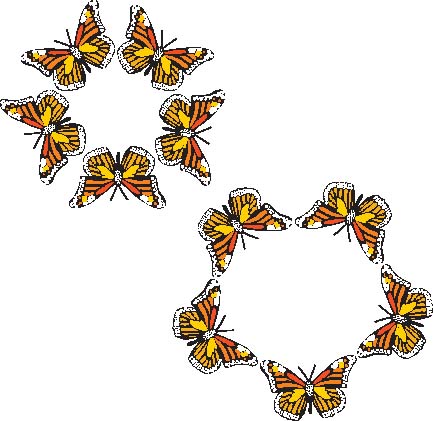
- There are 10 butterflies.
They are in 2 groups.
There are 5 butterflies in each group.
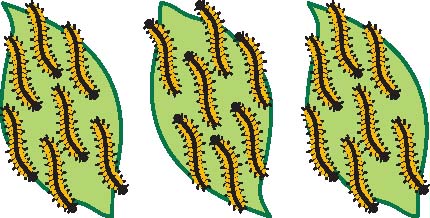
There are _____ caterpillars.
They are in _____ groups.
There are _____ caterpillars in each group.
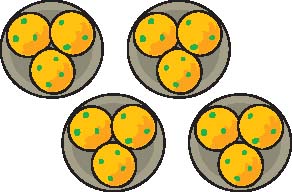
There are _____ laddoos.
They are in _____ groups.
There are _____ laddoos in each group.
Draw 18 stars.
Put them into 2 equal groups.

There are _____ stars in each group.
Draw 18 beads.
Put them into 3 equal groups.

There are _____ beads in each group.
Share the Grains

Mummy bird brings 12 grains.
How to distribute equally?
Mummy bird starts by giving 1 grain to each baby.

Then Mummy bird gives one more grain to each baby.

Each baby has got 2 grains now. How many grains are left? _____
She puts one more grain in each baby’s mouth. All the grains are finished.

12 grains have been divided among 4 baby birds.
Each baby has got 3 grains.
12 ÷ 4 = 3
Try These Now.......
Gopu has 3 plates of jalebis.
Each plate has a different number of jalebis.
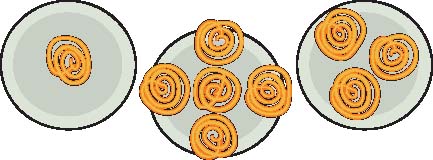
Now draw the jalebis on the plates below, so that each plate has the same number of jalebis.

How many jalebis are there altogether? _____
How many jalebis are there in each plate? _____
Discuss in the class how you found the answer.
Sharing them Equally
- Here are six bananas.

Here are three monkeys.
If they share the bananas equally, each monkey will get two bananas.
6 bananas divided into 3 equal parts = 2 bananas each 6 ÷ 3 = 2

If there are six bananas.

and two monkeys,
each monkey will get three bananas.
Six bananas ÷ 2 = 3 bananas each 6 ÷ 2 = 3


What if there are 600 bananas and two monkeys?
Give children the experience of sharing things equally and writing corresponding division statements.
If there are 60 bananas and two monkeys, how many will each monkey get?
_____ bananas.
- Five friends found 10 five-rupee coins on the ground.
They shared them equally.
Each friend got ten rupees.
50 ÷ 5 = 10
If there are 16 ten-rupee notes and four friends to share, then
16 ÷ 4 = and 4 *10 = 40
so each friend gets _____ rupees.
Five friends found Rs 100. If they share it equally, how much will each get? _____
Hari Prashad has 30 metres of rope. He distributes it equally among his three children.
Each child gets _____ metres of rope.
If there is 36 metres of rope, how much of rope will each child get? _____
And if there is 60 metres of rope, how much will each child get? _____
How Many Shelves?
I have 20 books. I can keep 5 books in one shelf, so how many shelves do I need in my almirah?
Five books in the first shelf. 15 books are left.

5 more books in the second shelf. 10 books are left.

5 more books in the third shelf. 5 books are left.

5 more books in the fourth shelf. 20 books have filled up 4 shelves of the almirah.
20 books put into equal groups of 5 each take 4 shelves.

On this and the following page, division is done by making equal groups. For instance, here equal groups of 5 books each have been made. This process is different from
Now let us try this.
Here are 28 buttons.

A tailor puts 4 buttons on one shirt.
So now there are 7 shirts with buttons.

28 ÷ 4 = 7
If there are 28 buttons, and the tailor puts 7 buttons on each shirt, there will be _____ shirts with buttons.
28 ÷ 7 = _____
Practice Time
1. Minku puts her 15 laddoos equally into 5 boxes.

(i) How many laddoos will there be in each box?
There will be _____ laddoos in each box.
15 ÷ 5 = _____
(ii) If she uses only 3 boxes, how many laddoos will there be in each box?
There will be _____ laddoos in each box.
_____ ÷ 3 = _____
2. Share 25 bananas among 5 monkeys. How many bananas for each monkey?
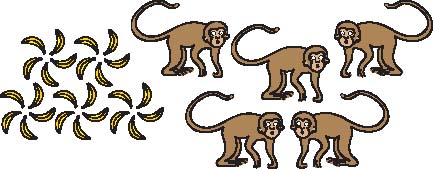
_____ ÷ 5 = _____
Each monkey has _____ bananas.
3. Share 12 balloons among 3 boys. How many balloons for each boy?

_____ ÷ _____ = _____
Each boy has _____ balloons.
4. There are 21 candles. Put them equally in 3 boxes. How many candles are there in each box?

_____ ÷ _____ = _____
5. There are 18 socks.
How many girls can wear these socks?

6. Raj has 36 minutes to make rotis. One roti takes 3 minutes. How many rotis can he make in this time?
He can make _____ rotis.
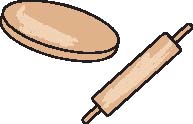
7. These are 24 footmarks of goats. So how many goats were there?

8. Some girls are playing a game with both their hands.
The girls who are playing have 60 fingers altogether.
How many girls are playing this game?

9. Lakshmi has 27 kg potatoes to sell. Three men came and bought equal amounts of potatoes.
Each man bought _____ kg of potatoes.

Jumpy Animals
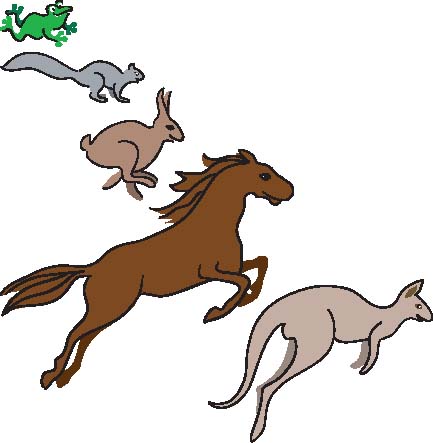
A frog jumps 2 steps at a time.
A squirrel jumps 3 steps.
A rabbit jumps 5 steps.
A horse jumps 15 steps.
A kangaroo jumps 30 steps.
Use the path on the next page to find out:
1. In how many jumps will the frog reach 30?
30 ÷ 2 = _____
2. In how many jumps will the squirrel reach 27?
27 ÷ 3 = _____

3. Which number will the kangaroo reach in two jumps?
4. Who all will meet at the number 15?
_____, _____, _____
5. Will the rabbit ever be at the number 18? _____
6. How many jumps of the rabbit equal one jump of the horse? _____
7. How many jumps of the horse equals two jumps of the kangaroo?
8. Which is the smallest number where the frog and the squirrel will meet?
How Quick Are You?
- Divide into groups of 2 using 2 times table.
18 ÷ 2 = 9 Hint: 5 * 2 = ?
18 ÷ 9 = 2
16 ÷ 2 =
20 ÷ 2 =
_____ ÷ 2 = 7
_____ ÷ 2 = 10
8 ÷ _____ = 4
_____ ÷ 2 = 5
- Divide into groups of 5 using 5 times table.
10 ÷ 5 = _____ Hint: 5 * 2 = ?
20 ÷ _____ = 4 _____
15 ÷ 5 = _____ _____
40 ÷ _____ = 8 _____
20 ÷ 5 = _____ _____
_____ ÷ 5 = 6 _____
25 ÷ 5 = _____ _____
_____÷ 5 = 3 _____
30 ÷ 5 = _____ _____
_____ ÷ 5 = 2 _____
- Divide into groups of 10 using 10 times table.
20 ÷ 10 = _____ _____
30 ÷ 10 = _____ _____
40 ÷ 10 = _____ _____
50 ÷ 10 = 4 _____
40 ÷ = 8 _____
÷ 10 = 5 _____
÷ 10 = 3 _____
÷ 10 = 2 _____
÷ 10 = 6 _____
Encourage children to explore the use of multiplication facts for division through mental computation.
Try these
4 ÷ _____ = 2 _____
14 ÷ 7 = _____
6 ÷ 3 = _____
_____ ÷ 2 = 7 _____
_____ ÷ 2 = 3 _____
15 ÷ 3 = _____
8 ÷ 4 = _____
15 ÷ 5 = _____
8 ÷ ____ = 4 _____
_____ ÷ 2 = 8
9 ÷ 3 = _____ _____
18 ÷ 9 = _____ _____
____ ÷ 2 = 5 _____
20 ÷ 5 = _____ _____
12 ÷ 4 = _____ _____
20 ÷ 4 = _____ _____
12 ÷ _____ = 2 _____
_____ = _____ _____
_____ = _____ _____
_____ = _____ _____
PuZZle
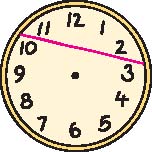
Divide the clock face into three parts so that the sum of the numbers in each part is the same.



